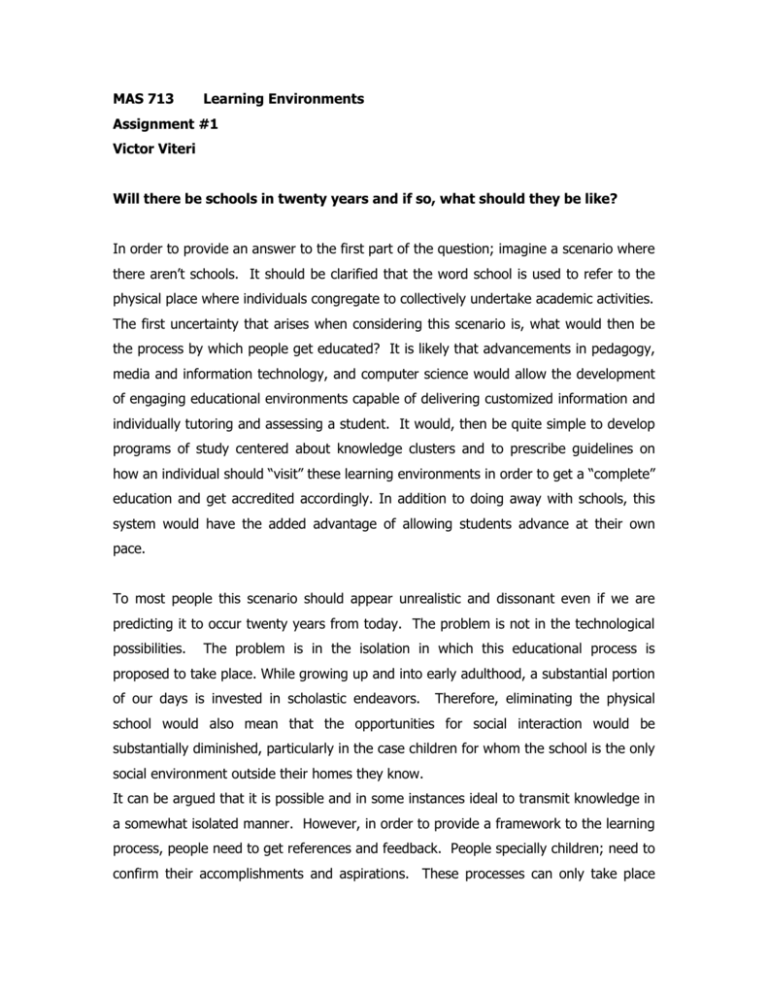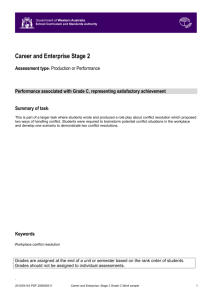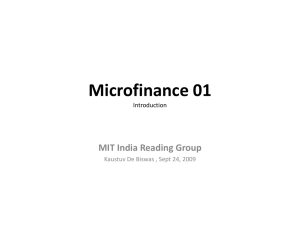Will there be schools in twenty years and if so, what should they be like
advertisement

MAS 713 Learning Environments Assignment #1 Victor Viteri Will there be schools in twenty years and if so, what should they be like? In order to provide an answer to the first part of the question; imagine a scenario where there aren’t schools. It should be clarified that the word school is used to refer to the physical place where individuals congregate to collectively undertake academic activities. The first uncertainty that arises when considering this scenario is, what would then be the process by which people get educated? It is likely that advancements in pedagogy, media and information technology, and computer science would allow the development of engaging educational environments capable of delivering customized information and individually tutoring and assessing a student. It would, then be quite simple to develop programs of study centered about knowledge clusters and to prescribe guidelines on how an individual should “visit” these learning environments in order to get a “complete” education and get accredited accordingly. In addition to doing away with schools, this system would have the added advantage of allowing students advance at their own pace. To most people this scenario should appear unrealistic and dissonant even if we are predicting it to occur twenty years from today. The problem is not in the technological possibilities. The problem is in the isolation in which this educational process is proposed to take place. While growing up and into early adulthood, a substantial portion of our days is invested in scholastic endeavors. Therefore, eliminating the physical school would also mean that the opportunities for social interaction would be substantially diminished, particularly in the case children for whom the school is the only social environment outside their homes they know. It can be argued that it is possible and in some instances ideal to transmit knowledge in a somewhat isolated manner. However, in order to provide a framework to the learning process, people need to get references and feedback. People specially children; need to confirm their accomplishments and aspirations. These processes can only take place within the context of a social fabric. Additionally, since children are rapidly exposed to changes and often are not explicit about their needs, this supporting fabric has to be immediately available to them. Furthermore educational processes get stimulus and are greatly enriched by social interaction. In fact there are instances where these interactions are absolutely necessary to learning such as in mentor apprentice relationships. It should also be considered that in the absence of stronger social structures, schools have become the stage where growing individuals affirm and in some cases attain their ethical principles. Since a complete education must include learning social responsibility, the elimination of school would probably handicap more than enhance the academic process. Finally, individuals often find that socially based extracurricular activities such as organized sports and clubs are as important to personal development as formal education. There are other issues, practical in nature, to which the no-school scenario would have to respond. For instance, who is going to supervise and care for children during the day? Where are teachers going to go? So while the previous discussion argue strongly against the elimination of the school, it is the presence of these practical inconveniences that makes this scenario totally unfeasible. In twenty years and in view of the rapid the changes brought about by emerging technology and social globalization, schools should evolve into substantially different entities from what they are now. Changes should occur in the way schools are organized and assemble their students. Schools should also change the content of their curricula and their pedagogical strategies. Academic entities are organized in well-defined hierarchies where the upper echelons set the demands on the lower levels. ultimately defines what is instructed. At the highest level is the job market, which In recent years, job duties have shifted from mostly process-oriented tasks to analytical and creative activities. These activities require independent critical-thinking, and a capacity to understand and synthesize concepts. These skills are best relayed through processes of guided exploration and intense levels of tutoring. Schools, however, are ill structured to respond to these demands. Student segregation and lecturing to large groups of students are ideally suited to teach memorization and routine procedures. As a result, the school framework will have to change. To accommodate the necessary changes, schools should turn to media based learning environments for content delivery and invest teacher’s time in providing students with tutoring and feedback. By minimizing the need to teach pupils collectively, schools would also eliminate the practical need to segregate students. Schools could then assemble in studios where students of different age groups and ability levels would explore ideas in workshop-type environments. Depending on the topic and area of study, these workshops would engage students in team or individual multidisciplinary projects. Teams would incorporate students of different levels and areas of interest. Projects would chosen for their social and scientific relevance and should produce a tangible result. For instance, students could build objects, develop a script and/or perform a play. Longer lasting projects could address issues and/or analyze facts, and make them explicit through a student newsletter; the possibilities are endless. Students would be assessed according to their individual progress and on how they meet the project requirements. Most importantly, however, pupils would have to stage their work. At the lower levels, these presentations would be more like show-and-tell while on higher level projects, presentations would consist of open forum critiques or performances. Although students would be primarily guided by a project-teacher, the studio environment would allow teams and individuals to get advice from other faculty and fellow students. In fact, as a requirement, upperclassmen should at some point formally tutor other students. Media based tools would be the primary sources of information, teachers, however, would still have to lecture on critical and specific areas. To provide a framework to an otherwise flexible school day, these lectures and/or seminars would be scheduled at well spaced but predetermined time intervals. A final issue to consider is how to bring about the changes that would be needed to turn our present school systems into educational workshops. I believe that technology is the key and that it has already triggered a supply driven evolutionary process. This process is imperceptible since it is characterized by the adoption of small incremental innovations, such as the implementation of computers in classrooms. As the adoption rate increases, evolution will turn into a demand driven process. This change will result in a second generation of innovations that will bring the schools closer to the ideal state. For innovations to diffuse, it is absolutely necessary that seamless transitions occur when adopting new technologies. For instance, teachers should not have to be retrained every time a new learning environment is adopted. As technology progresses new environments should do more and require less from the end users. As a result, specialized research will play an external but very significant role in the transformation of schools. Summary In the year 2021 children, adolescents and young adults will still go to a place called school. There will still be football, cheerleading, prom and graduations. Teachers will still be teachers and academic pressures and competition will still be part of growing up. There will be preppies and jocks. Dropouts, however, will have become scarce. Workshop based education will have a place for everyone and most people will enjoy learning. Physically the school will also look different. Workshop room would be provided with plenty of learning toys such as computer simulators, tools and didactic widgets. The most noticeable aspect, however, will be the absence of bolted down chairs This radical change will not occur at the stroke of a pen; it will be a gradual process. Technology, particularly media and computer sciences will play a significant role in this change.






